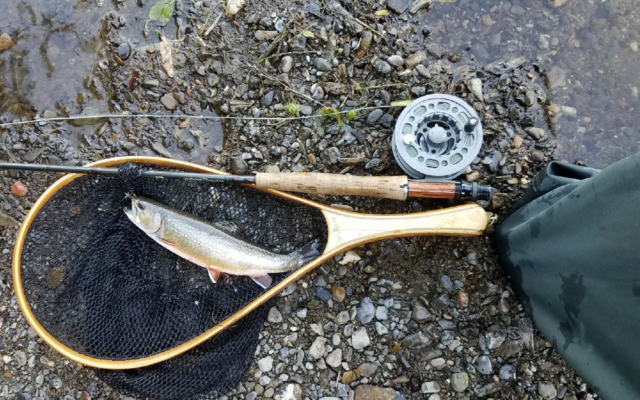
Why fish with a wet fly
By Bill Graves, Pine Tree Woods & Waters
Just in case you’re wondering, the true definition of a “wet†fly is not one that has just been cast into the water. Larger and sleeker than dry flies, yet smaller and more intricately colored than many streamers, this style of trout fly comes from a centuries-old fishing heritage.
The first wet flies were no more than chicken or duck feathers roughly attached to hooks with little form or fashion, yet they would attract fish when natural baits would not. As the fish have become more “lure educated” over the decades, the fly tiers and fly casters have kept changing and updating wet fly patterns and fishing methods.
In Maine, the style and tradition of angling with wet flies has taken a back seat to trolling streamers and dapping dry flies. But during summer months, the vibrant colors of a well-presented and retrieved wet fly on regional woods-lined brooks will take larger trout than other types of flies.
Many of the flies have vivid reds, blues, yellows and greens that resemble no insect or aquatic bait, yet the trout strike them readily.
There is an old wet fly pattern called a trout fin, whose red and white swept-wing style came from anglers using an actual trout fin attached to a hook. The trout fin pattern was and is a very productive offering and should be in each fly box.
The red and white of a Parmachene Belle and Royal Coachman, yellow and red of a professor, green and red of a grizzly King, and the blue, red and yellow of a silver doctor are the rainbow-colored patterns that seem to always catch fish.
Among the more subdued hues in feathered creations that are dependable wet flies and should be in each tackle box are the hornberg, hare’s ear, Montreal and muddler patterns. The most common size wet fly hooks are 8s,10s and 12s.
Wet flies will take fish on rivers that have deep holding pools during warm weather, but are even more effective on medium-sized streams and small creeks where trout take respite from the lower water levels and higher temperatures of the larger waterways.
I’ve found that wet flies also seem to attract the larger trout from among the schooled-up fish near springs and ledge seeps. These small creeks are inlets into larger streams, and as the weather warms up the big waters, many trout move into the cooler feeder brooks and readily take sleek, taunting, undulating wet flies.
Wet flies work best when fished through moderate depth riffles and currents. These spots are easy to locate on straight stretches, but don’t overlook U and S curves with shade from overhanging foliage along the brook flowage, and always cast along bank undercuts.
The nice thing about wet fly fishing is that it doesn’t require the training, concentration and finesse of dry fly fishing. Novice casters can present a wet fly well enough to attract fish.
A 7.5 or 8-foot, 5-weight rod with moderate action, and a 5- or 6-weight floating fly line attached to a 7.5 -foot leader tapered to 4-pound test tippet will work for most wet fly casting. The wet fly patterns may be more difficult to locate than the rod, but the effort will be worth it.
Since wet fly patterns have lost the favor of many casters, anglers may have to tie their own or find a local fly tier to create a few.
I’ve discovered a handful of effective but often overlooked or even unheard of wet fly patterns. Materials and construction directions may be found in dozens of older fly-tying tomes or in many cases online at many fly-tying blogs.
I prefer a brightly hued wet fly such as a professor, Colonel Fuller or a Belgrade during the day when the sun is high overhead. A drab color pattern like a blue dun, ginger quill or a March brown often provide consistent trout action at dawn and dusk.
At certain times of the season, wet flies outperform most other styles of baits; now is one of those times.